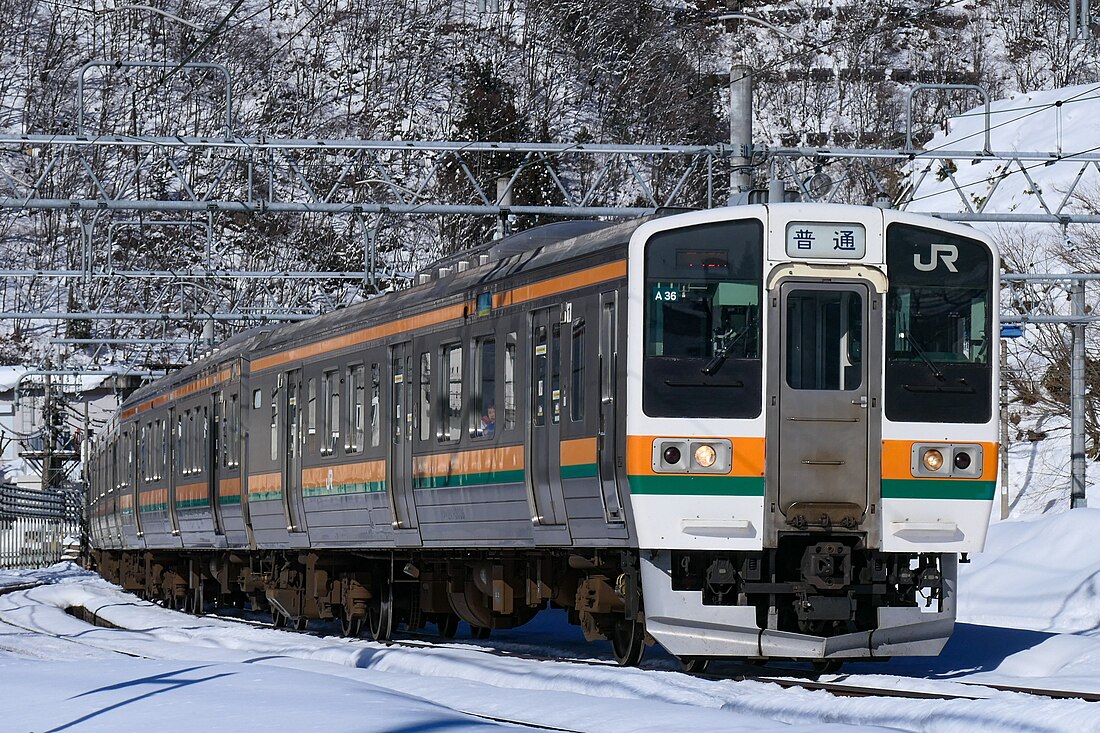Top Qs
Timeline
Chat
Perspective
211 series
Japanese train type From Wikipedia, the free encyclopedia
Remove ads
The 211 series (211系, 211-kei) is a suburban electric multiple unit (EMU) train type introduced in 1985 by the Japanese National Railways (JNR). The trains are still being used by the East Japan Railway Company (JR East). They were formerly used by the West Japan Railway Company (JR-West) and the Central Japan Railway Company (JR Central) in Japan.
This article needs additional citations for verification. (January 2023) |
Remove ads
Design
The 211 series was developed by JNR to replace older 113 series and 115 series trains. The 211 series incorporated regenerative brakes and stainless steel body construction.
Variants
- 211-0 series (basic version with transverse seating)
- 211-1000 series (cold region version with transverse seating)
- 211-2000 series (basic version with all longitudinal seating)
- 211-3000 series (cold region version with all longitudinal seating)
- 211-5000 series (JR Central version)
- 211-6000 series (JR Central version with single motored car)
- Joyful Train variants (JR West version)
Operations
Summarize
Perspective
211-0, 211-2000 series
- Tōkaidō Main Line and Ito Line: Tokyo – Numazu/Ito (From 1986 - April 2012)
- Tōkaidō Main Line: Hamamatsu – Maibara
- Chūō Main Line: Tachikawa – Shiojiri
- Shinonoi Line: Shiojiri – Shinonoi
- Shinetsu Line: Shinonoi – Nagano
- 211-0 series in original JNR livery in August 1988
- 211-0 series in JR livery in December 2009
- 211-0 series interior view, February 2010
- 211-2000 series interior view, November 2021
- Green car seating, July 2010
211-1000, 211-3000 series
- Tohoku Main Line: Oyama – Utsunomiya[1]
- Takasaki Line: Ueno - Takasaki (1986 - March 2014)
- Ryomo Line: Takasaki – Oyama
- Shinetsu Line: Takasaki – Yokokawa
- Oito Line: Matsumoto –Shinano-Omachi
- Chuo Main Line: Tachikawa – Shiojiri/Shiojiri – Nakatsugawa
- Shinonoi Line: Shiojiri – Shinonoi
- Shinetsu Main Line: Shinonoi – Nagano
- Sobu Main Line: Chiba – Chōshi (via Yachimata) (21 October 2006 – 2012)[2][additional citation(s) needed]
- Narita Line: Chiba – Chōshi (via Narita) (21 October 2006 – 2012)[2][additional citation(s) needed]
- Kashima Line: Sawara – Kashima-Jingu (21 October 2006 – 2012)[2][additional citation(s) needed]
- Togane Line (since 21 October 2006 – 2012)[2][additional citation(s) needed]
- Uchibo Line: Chiba – Awa-Kamogawa (via Kisarazu) (21 October 2006 – 2012)[2][additional citation(s) needed]
- Sotobo Line: Chiba – Awa-Kamogawa (via Katsuura) (21 October 2006 – 2012)[2][additional citation(s) needed]
- Iida Line (since 15 March 2014)[3]
- Agatsuma Line (since 22 August 2016)[1]
- Joetsu Line: Takasaki - Minakami (since 23 August 2016)[1]
- 211-3000 series with additional pantograph in March 2022
- 211-3000 series in Nagano area livery in January 2022
- 211-3000 series in Chiba area livery in May 2010
- 211-3000 series interior view, February 2022
- Priority seats, February 2022
211-5000, 211-6000 series
- Tokaido Main Line: Atami – Toyohashi
- Chuo Main Line: Nagoya – Nakatsugawa
- Kansai Main Line: Nagoya – Kameyama
- Gotemba Line: Kōzu – Numazu
- Minobu Line: Fuji – Nishi-Fujinomiya
- Aichi Loop Line: Kozoji – Setoguchi
- 211-5000 series in December 2019
- 211-5000 series interior view, September 2021
- Priority seats, September 2021
Sangi Railway

On 20 and 22 March 2024, JR Central transferred five three-car 211-5000 series sets to Sangi Railway.[4][5]
Remove ads
Joyful Train sets
- Super Saloon Yumeji: Three-car set converted from 211 and 213 series coaches which entered service in 1988 and withdrawn in March 2010. Operated by JR-West and based at Okayama Depot.
- Joyful Train 211 series in JR-West Livery in January 1989
- Interior view, September 2003
See also
References
External links
Wikiwand - on
Seamless Wikipedia browsing. On steroids.
Remove ads















